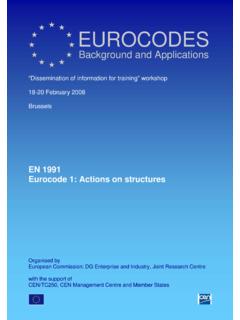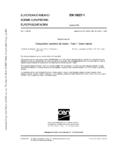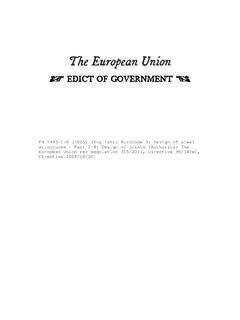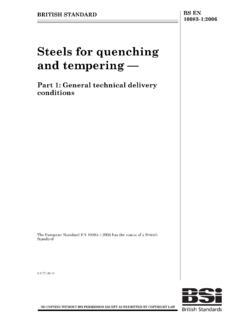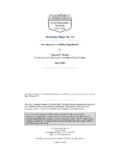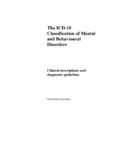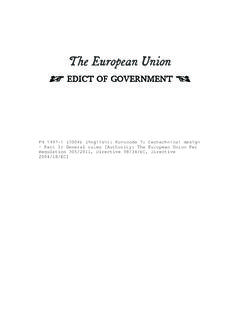Transcription of EN 1992-1-1 Companion - eurocodes.fi
1 Final Research Report: BD 2403 Companion DocumentEN 1992 -1-1: Eurocode 2: Design of ConcreteStructures Part 1: General rules and rulesfor buildingsCompanion DocumentEN 1992 -1-1: Eurocode 2: Design of ConcreteStructures Part 1: General rules and rulesfor buildingsAugust 2007 Department for Communities and Local Government: LondonFinal Research Report: BD 2403 The support of The Concrete Centre in finalising this report is this document provides practical guidance on the use of Eurocode BS EN 1992 -1-1 andBS EN 1992 -1-2 for the design of buildings, it shall only be applied in conjunction with both theEurocode and its National Annex published by the British Standards should be noted that this guidance has been based on the published Eurocode, BS EN 1992 -1-1:2004 and EN 1992 -1-2: 2004 together with the draft of the respective NationalAnnexes, as available at the time of writing (January 2005).
2 Department for Communities and Local GovernmentEland HouseBressenden PlaceLondonSW1E 5 DUTelephone: 020 7944 4400 Website: Crown Copyright, 2007 Copyright in the typographical arrangement rests with the publication, excluding logos, may be reproduced free of charge in any format or mediumfor research, private study or for internal circulation within an organisation. This is subject toit being reproduced accurately and not used in a misleading context. The material must beacknowledged as Crown copyright and the title of the publication other use of the contents of this publication would require a copyright licence.
3 Please applyfor a Click-Use Licence for core material at ,or by writing to the Office of Public Sector Information, Information Policy Team, St ClementsHouse, 2-16 Colegate, Norwich, NR3 1BQ. Fax: 01603 723000 or email: you require this publication in an alternative format please and Local Government PublicationsPO Box 236 WetherbyWest YorkshireLS23 7 NBTel: 08701 226 236 Fax: 08701 226 237 Textphone: 08701 207 405 Email: online via the Communities and Local Government website: 2007 Product Code: 07 BD 04723 (h)CONTENTSFOREWORD, SCOPE AND OBJECTIVES OF THE Companion Current status of Scope and objectives of Companion Document to EN1992-1-1: Eurocode 2: 5 Design of Concrete Structures Part 1.
4 General rules and rules for Features of EN 1992 1 The Eurocodes, background, objectives and their Relationship between the Eurocodes and National Regulations/7 Public Authority RequirementsCHAPTER The Eurocode Differences in philosophy between existing British Standards and Supporting and related documents (product standards etc): 10 Required and Eurocode terminology and The use of EN1992-1-1 for structural concrete Role of National Annex Using EN Eurocode at a National level12 CHAPTER 215 Basis of Structural The use of EN1990 for structural concrete Resistance partial factors21 CHAPTER Concrete Comparison between EN 1992 -1-1 and BS Reinforcement and prestressing steel Comparisons between 23EN 1992 -1-1 and BS Ductility requirements24 CHAPTER 425 Durability and cover to Comparison between EN 1992 -1-1 and BS Determination of required cover and link to design working life 25and exposure classCHAPTER 526
5 Structural Load cases and Geometric Idealisation of Slenderness and effective length of isolated Biaxial bending29 CHAPTER 631 Ultimate limit Design of flexural elements at the ultimate limit Design of compression elements at the ultimate limit Flat slabs and design for punching Material Partial Safety Comparative design study39 CHAPTER 742 Serviceability limit Serviceability design and Span/depth Partial factors for material properties for serviceability limit state 43verificationsCHAPTER 844 Additional guidance in EN 1992 -1-1 (Sections 8 12 and Annexes) Section 8 Detailing of reinforcement general and Section 9 44 Detailing of members and particular Section 10 Precast concrete elements and Section 11 Lightweight aggregate concrete Section 12 Plain and lightly reinforced concrete Materials and Annexes to EN 1992 -1-146 CHAPTER Availability of Guidance for EN Impact on the Concluding remarks48 REFERENCES51 FOREWORD, SCOPE AND OBJECTIVESOF THE Companion Current status of EurocodesThe complete suite of the CEN Structural Eurocodes will be converted to full EN(European Standard) by 2005.
6 This will include the package of codes relating tothe design of buildings in concrete. Following a period of co-existence betweenthe Eurocodes and the present National Codes, the National Codes will cease tobe maintained; this period is expected to be about 5 years after conversion. TheEuropean Commission, in close co-operation with representatives of MemberStates has prepared a document Application and Use of the Eurocodes [1],and Recommendations for the use of the Eurocodes [2]. Scope and objectives of CompanionDocumentto EN1992-1-1: Eurocode 2: Designof Concrete Structures Part 1: General rulesand rules for buildingsThis Companion guide is intended to be a high level document, whose targetaudience are principally senior members of the profession.
7 The document islikely to have a limited life and serve as an aid to introduce EN1992-1-1 [3]during the period of co-existence (see ). This guide should not be useddirectly for design purposes. It follows the format of EN1992-1, with Chapters 1to 7 covering Sections 1 to 7 of EN 1992 -1-1 and with Chapter 8 coveringSections 9 to 12. The Companion Document seeks to identify and discusswhere appropriate The main differences between EN 1992 -1-1 and BS 8110 Philosophical similarities between EN 1992 -1-1 and BS 8110 Changes in design principles Process change/design impact Information on handbooks, worked examples and other guidance on EN1992-1-1.
8 Application within the UK together with the BSI National an explanation of the symbols used in this Companion document, the readershould refer to EN 1991-1-1 or BS 8100 as appropriateThe editorial style of EN 1992 -1-1 (see ) is different from UK 8110 gives direct guidance for the design of different member types, whereasEC2 concentrates on design principles. In this context the additional guidanceproduced by different organisations should prove invaluable to the UKprofession; in particular the EN 1992 -1-1 How to design leaflets (see (2)),explaining the basic design concepts for structural Features of EN 1992 1 1EN 1992 -1-1 gives general rules for all structures and comprehensive rules forthe design of buildings in plain, reinforced and prestressed concrete.
9 Bothnormal weight and lightweight concrete are Sections in EN 1992 -1-1 explain the basis of different phenomena ( , shear, bond) rather than member types ( beams, slabs, columns).All Eurocodes use the limit state approach and the partial factor method The Eurocodes, background, objectives andtheir statusThe Commission of the European Community decided on an action programmein the field of construction based on article 95 of the Treaty of Rome. Within thisaction programme the Commission took the initiative to establish a set ofharmonised technical rules for the structural design of construction works, withthe following European Commission objective: The Eurocodes to establish a set of common technical rules for the design ofbuildings and civil engineering works which will ultimately replace thediffering rules in the various Member States.
10 The Commission established in the mid 1970 s, a Steering Committeecontaining representatives of Member States, whose work on the Eurocodesprogramme, led to the publication of a set of first generation Eurocodes afterfifteen 1989 a Special Agreement was made between CEN and the EuropeanCommission bringing the responsibility of producing the structural Eurocodesto CEN. The agreement also specified that the Eurocodes are to serve asreference documents to be recognised by authorities of the Member States forthe following purposes:a) as a means of compliance of building and civil engineering works with theEssential Requirements as set out in Council Directive 89/106/EEC (TheConstruction Products Directive), particularly Essential Requirement No 1 Companion Document to EN 1992 -1-16 Mechanical resistance and stability and Essential Requirement No 2 Safetyin case of fire.

